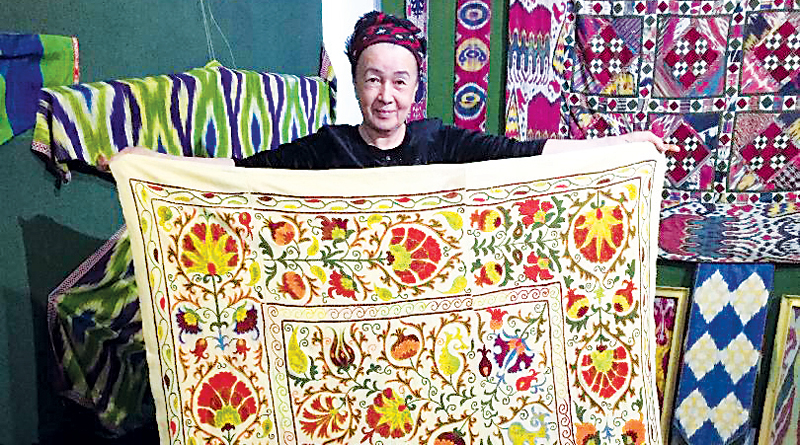THE ANCIENT TEXTILE TRADITIONS OF UZBEKISTAN – Around The Frame

As Nancy explains it, “This ‘road’ was a network rather than a single highway which carried not only silk but exchanges of religion, technology, art ideas and creativity. We visited a silk factory (my favorite), pottery workshop, paper making center, wood carvers workshop, knife making shop, colorful bazaars, and of course the famous mosaic tile covered madrassahs (ancient religious educational structures), some over 100 feet tall and 500 years old.”
Nancy continued, “The textiles we saw were spectacular. I collect antique quilts and was excited to find a large 120+ year-old suzani at an antique store in Bukhara, Uzbekistan.” A suzani is a decorative textile hand embroidered with silk thread. The ground or base fabric is a heavy cotton woven in strips. Traditionally the bride and the bride’s family made the suzani and constructed it like later quilters would gather for a quilting bee. It is interesting to look at the back and see that the work has been done by different people. Because of the weight of the suzani, there normally is no backing. The work of art was then presented to the husband on the wedding day. Suzanis are used as a “wedding curtain,” wall hanging, bed covering or to cover a pile of bedding. Some believe they were used to block evil spirits from the room. “The intricate designs all have symbolic meanings: the pomegranate is very commonly used since it is full of seeds signifying fertility and abundance. Wavy stems signify wealth and vitality, while tear drops and almonds stand for abundance. The flowers which are the paradise garden in the desert, bring luck, good health and longevity. The peppers around the edge protect from evil spirits. These older suzanis have many bright colors because each color helps protect against difficulties and disease,” Nancy shared.
Another beautiful fabric from Uzbekistan is ikat (pronounced “eye-cat”). This textile is made from a resist dye process, using completely natural dyes. The vertical threads are bound and dyed and then separated and woven with horizontal threads which are slightly off-set to produce a watery look. Some are all silk, some have cotton horizontal threads and others are all cotton.
Nancy reminisced, “We found the people we met to be very colorful and extremely friendly. Our guide even took us to his home to meet his daughter, wife, mother and father. The food was delicious, especially the soft fluffy non (bread) and their national dish plov (lamb, rice, vegetables and flavoring which differs from region to region).
If you decide to go, and I highly recommend the trip not only for the textiles but the ancient architecture and culture too, take note in the entire country of Uzbekistan, they do not accept credit cards; only cash! Since I was not prepared to find such a special textile, a very generous traveler on our tour loaned me the cash until we got home and I could send her a check!”
Thank you, Nancy, for sharing your inspirational textile trip with us. Whether it is the main focus of a trip or not, learning about a country’s textile traditions is just as interesting as learning about their culinary ones. I look forward to sharing your stories of teaching quilting to Mongolian women in a future issue.
For more textile photos of Nancy’s trip go to the Born Again Quilts’ Facebook page.
- The Stars & Stripes Are Forever: Around The Frame - July 5, 2024
- Sam Butcher: A Life Filled With Precious Moments ~ Around The Frame - June 7, 2024
- Aunt Dora & Her Well-Lived Life ~ Around The Frame - May 10, 2024


